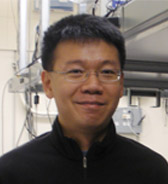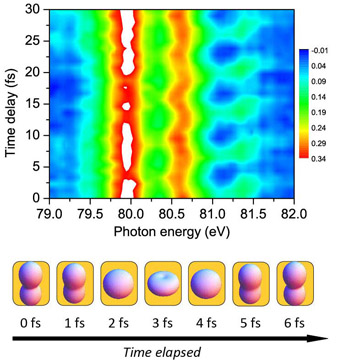LOH Zhi Heng
Associate Professor, Division of Chemistry and Biological Chemistry
School of Physical and Mathematical Sciences, Nanyang Technological University
| Phone: | (65) 6592 1655 |
| Email: | zhiheng@ntu.edu.sg |
| Education: | S.B., MIT; Ph.D. & Post-doc, University of California, Berkeley |
Research Interests
The central theme of our experimental research program is the study of coherent electron and nuclear dynamics in molecules. Coherent electron motion and the ensuing quantum dynamics set forth by either optical excitation or nonresonant strong-field ionization of molecules by few-cycle laser pulses will be probed with attosecond to femtosecond time resolution. The typical ~1-eV energy spacing between occupied frontier molecular orbitals translates to a periodicity of a few femtoseconds for the coherent electron motion. Charge migration that is mediated by electronic quantum coherences therefore occurs at rates that are at least two orders of magnitude faster than Marcus-type charge transfer. Moreover, the comparable time scales for motion of the electronic and nuclear wave packets presents, in many cases, the possibility of unraveling non-Born-Oppenheimer dynamics.
The main experimental techniques we employ are core-level transient absorption and transient photoelectron spectroscopies, in which extreme ultraviolet pulses produced by high-order harmonic generation will be used as probe. The ultimate goal of our studies is to exploit quantum coherences to enhance the performance of nanoelectronics and artificial light harvesting systems.

Selected Publications
- Z.-H. Loh, M. Khalil, R. E. Correa, R. Santra, C. Buth, and S. R. Leone, “Quantum state-resolved probing of strong-field-ionized xenon atoms using femtosecond high-order harmonic transient absorption spectroscopy,” Phys. Rev. Lett. 98, 143601 (2007).
- Z.-H. Loh, C. H. Greene, and S. R. Leone, “Femtosecond induced transparency and absorption in the extreme ultraviolet by coherent coupling of the He 2s2p (1Po) and 2p2 (1Se) double excitation states with 800 nm light,” Chem. Phys. 350, 7 (2008). (Invited article for the special issue on Femtochemistry VIII)
- Z.-H. Loh and S. R. Leone, “Ultrafast strong-field dissociative ionization dynamics of CH2Br2 probed by femtosecond soft x-ray transient absorption spectroscopy,” J. Chem. Phys. 128, 204302 (2008).
- E. Goulielmakis*, Z.-H. Loh*, A. Wirth, R. Santra, N. Rohringer, V. S. Yakovlev, S. Zherebtsov, T. Pfeifer, A. M. Azzeer, M. F. Kling, S. R. Leone, and F. Krausz, “Real-time observation of valence electron motion,” Nature 466, 739 (2010).